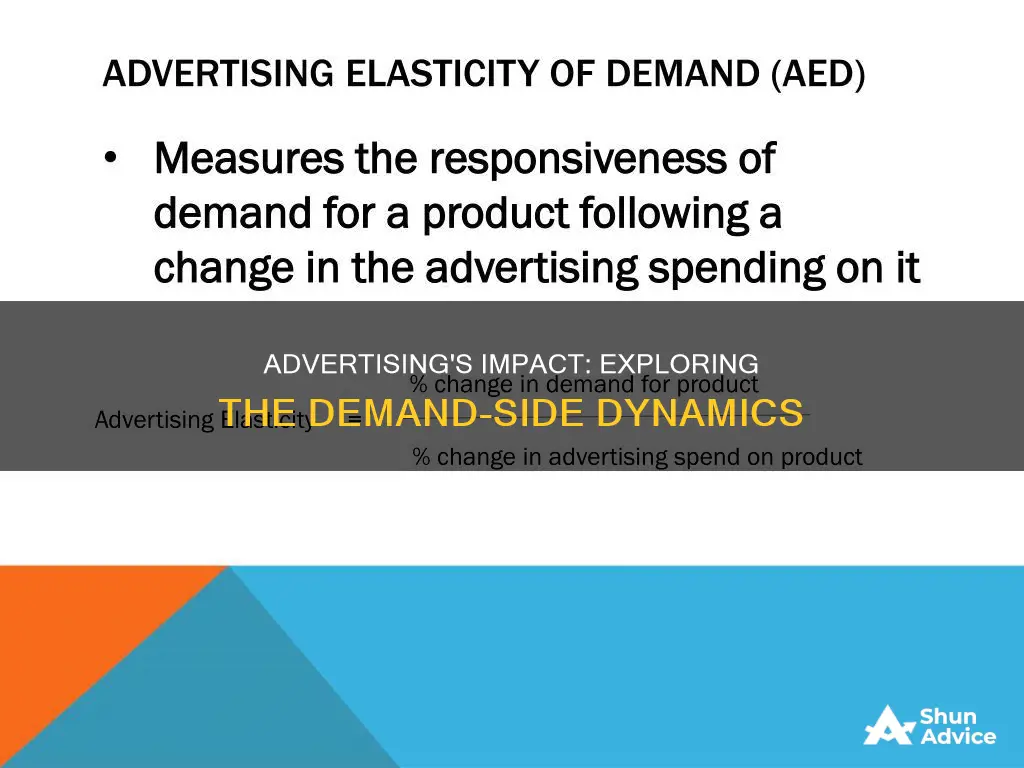
Investing in advertising can be an effective way to increase demand for a product or service. Advertising is a fundamental aspect of marketing, where businesses pay for promotional space to encourage consumers to purchase their product or service. It is most successful when targeted at a specific segment of an audience, considering factors such as age, gender, income, purchasing history, and social causes.
Advertising can build brand awareness, educate consumers, and differentiate a product or service from its competitors. It can also increase website traffic and remind existing customers about the business. However, it is important to research the target audience and select the appropriate advertising platforms to ensure effectiveness and avoid wasting funds.
The impact of advertising on demand can be measured through advertising elasticity of demand (AED), which calculates the percentage change in the quantity demanded by the percentage change in advertising expenditures. A positive AED indicates that increased advertising leads to a rise in demand.
Overall, investing in advertising can be a powerful tool to boost sales and revenue, but it should be approached strategically and with careful consideration of potential disadvantages and costs.
| Characteristics | Values |
|---|---|
| Advertising Elasticity of Demand (AED) | Measures a market's sensitivity to increases or decreases in advertising saturation |
| Advertising expenditure impact | Generates new sales for a company |
| AED calculation | Advertising elasticity of demand = % Change in Quantity Demanded / % Change In Advertising Spending |
| Positive AED | Indicates that an increase in advertising leads to a rise in demand for the advertised goods or services |
| AED limitations | AED may not be the most accurate predictor of advertising's impact on sales as it does not consider other factors that affect demand, such as changes in consumer tastes and spending habits |
| Advertising benefits | Informs customers about products, increases brand awareness, strengthens brand loyalty, reaches target customers, and increases sales |
| Advertising disadvantages | Can be costly, may irritate customers, and may not be worth the additional costs and risks |
What You'll Learn
- Advertising can create a sense of urgency to drive demand
- It can build brand awareness and loyalty
- It can also increase consumer awareness of a product's benefits
- Advertising can affect demand by building a desire for a product or brand in consumers’ minds
- It can help win over consumers from competitors or those wanting to try something new

Advertising can create a sense of urgency to drive demand
Advertising can be a powerful tool for creating a sense of urgency among consumers, prompting them to make purchases. This strategy taps into the "mere urgency effect", a psychological principle which states that people are more likely to act on a task when it is presented as urgent, even if the urgency is artificially created.
The scarcity principle is a commonly used marketing strategy that involves creating a sense of exclusivity or limited supply to increase demand. This can be achieved by promoting limited-edition items, exclusive sales, or limited stock. For example, advertising a limited number of tickets for an event can boost sales as consumers, driven by the fear of missing out, are compelled to make faster purchases.
To create a sense of urgency in their advertising, businesses can employ various tactics such as setting deadlines, using countdown timers, highlighting potential price increases, and showcasing real-time behaviour from other shoppers. These strategies play on the fear of missing out and encourage impulse purchases.
Additionally, using eye-catching visuals, bold colours, and clear messaging can help grab the attention of potential customers and create a sense of urgency. For instance, a simple yet effective message like "Today Only" can be a powerful motivator for consumers to take immediate action.
It is important to note that while creating a sense of urgency can be an effective strategy, it should be used in conjunction with a compelling offer that resonates with the target audience. A well-crafted advertisement that invokes urgency can be a powerful tool to drive customers to act quickly and increase demand.
Retirement Planning: Navigating Your Investment Journey
You may want to see also

It can build brand awareness and loyalty
Advertising can be an effective way to build brand awareness and loyalty, which in turn can lead to increased sales and market share. Brand awareness refers to how familiar a target audience is with a brand and how well they recognise it. Brands with high brand awareness are often referred to as 'trending' or 'popular'.
Advertising can help to build brand awareness by increasing the visibility of a brand and its products or services. This can be achieved through various channels such as social media, TV, billboards, and sponsorships. By investing in advertising, businesses can reach a wider audience and create a lasting impression.
Brand loyalty is when customers repeatedly purchase from the same brand and associate positive feelings with it. Advertising can foster brand loyalty by creating positive associations, building trust, and establishing an emotional connection with consumers. For example, advertisements can humanise a brand, give it a personality, and allow it to connect with its target audience on a deeper level.
Additionally, advertising can help to differentiate a brand from its competitors. By promoting unique selling points and highlighting how their products or services are better than those of their rivals, businesses can create a unique brand perception in the minds of consumers. This differentiation is crucial in creating brand loyalty, as it gives customers a reason to choose one brand over another.
Furthermore, advertising can also be used to reconnect with existing customers and encourage repurchases. By investing in advertising campaigns targeted at previous customers, brands can increase their retention and growth rates.
Overall, investing in advertising can be a powerful tool for building brand awareness and loyalty. By utilising different advertising strategies, businesses can create a strong brand identity, foster positive associations, and establish long-lasting relationships with their customers, ultimately leading to increased demand for their products or services.
The Debt Dilemma: Navigating Investments and Savings
You may want to see also

It can also increase consumer awareness of a product's benefits
Advertising is a powerful tool for increasing consumer awareness of a product's benefits and, in turn, driving demand. When a product is backed by a well-known brand, consumers are more likely to trust its quality and reliability, making brand awareness a critical factor in the success of any product.
Advertising can help build brand awareness and loyalty, differentiate a product from its competitors, and reach target customers. It is an efficient way for companies to inform customers about their products, explain how they stand out, and announce new products to the market. By investing in advertising, companies can increase consumer awareness of their product's benefits, creating a positive perception of the brand and its offerings.
For example, consider the soft drink industry. Coca-Cola and Pepsi have built strong brand awareness through advertising, which has led to higher sales. Their products, removed from their packaging, may be indistinguishable from other soft drinks, but brand awareness ensures consumers reach for their products.
Advertising can also help companies introduce new products to the market and educate consumers about their unique features and benefits. This is especially true for products in a highly saturated market, where advertising can help define a product's unique selling points. By investing in advertising, companies can increase consumer awareness of these benefits and create a positive perception, leading to increased demand.
Additionally, advertising can target specific customer groups and influence their purchase decisions. By researching the target market, companies can tailor their advertisements to highlight how their product's benefits satisfy the specific needs of those customer groups. This targeted approach can be highly effective in generating demand for the product.
Overall, investing in advertising can be a powerful tool for increasing consumer awareness of a product's benefits, creating a positive brand perception, and driving demand. By reaching the right customers and highlighting the unique features and advantages of a product, companies can successfully influence consumer behaviour and generate sales.
Eurozone's Financial Investment Impact: Navigating the Monetary Waves
You may want to see also

Advertising can affect demand by building a desire for a product or brand in consumers’ minds
Advertising can be an effective way to increase demand by creating a desire for a product or brand in the minds of consumers. This is achieved through a variety of strategies that leverage human psychology to build an emotional connection with the target audience.
Firstly, advertising campaigns aim to capture consumers' curiosity and intrigue them. This can be done through innovative and creative campaigns, compelling storytelling, or by addressing unmet needs in the market. By sparking curiosity, advertisers can create an initial interest in their product or service.
The next step is to establish a connection with the consumer by reflecting their self-image, aspirations, and values. Consumers are more likely to be drawn to brands that align with their personal beliefs and goals. This connection can be enhanced through emotional branding, where companies forge an emotional link between the consumer and the product or brand. This often involves storytelling and messaging that resonates with the target audience on a deeper, more personal level.
Exclusivity and scarcity are also powerful tools used in advertising to increase desire. Limited editions, exclusive offers, or members-only privileges create a sense of urgency and make consumers feel that they need to act quickly to acquire something distinctive. This tactic plays on the human tendency to want what we can't easily have.
Visual appeal is another important aspect of advertising that stimulates desire. Aesthetically pleasing design and imagery can appeal to the senses and make a product more desirable. Social proof, such as testimonials, reviews, and endorsements, further amplifies this desire by providing validation and enhancing the product's credibility.
By combining these elements, brands can create a compelling narrative that not only generates interest but also transforms it into a longing for their product. They can tap into consumers' emotions and aspirations, creating experiences and stories that people want to be a part of, thus increasing demand for their offerings.
Additionally, understanding the target audience is crucial for effective advertising. Demographic and psychographic data help advertisers tailor their messages to align with the core desires and aspirations of their target consumers. This ensures that the advertising campaign resonates with the intended audience and increases the likelihood of sparking desire and influencing purchasing decisions.
In conclusion, advertising can indeed affect demand by building desire for a product or brand in consumers' minds. By leveraging psychological insights, emotional connections, and creative strategies, advertisers can influence consumer behaviour and increase demand for their products or services.
Home Improvement: Who's Spending the Most?
You may want to see also

It can help win over consumers from competitors or those wanting to try something new
Advertising can be an effective way to build brand awareness and consumer trust, as well as to inform consumers about the benefits of a product or service. It can help businesses increase demand for their offerings, but it can also reduce demand if the advertising campaign is unsuccessful.
Advertising is a fundamental aspect of marketing, and it involves paying for promotional space to encourage consumers to purchase a product or service. Advertising is most successful when it targets a specific segment of an audience. Businesses can segment their audience in a number of ways, including demographic characteristics such as age, gender, and income, or behavioral characteristics such as purchasing history and social causes.
To increase demand for a product or service, businesses need to create messaging that outlines the problem consumers are facing and offers their product as the solution. This kind of persuasive advertising influences demand by setting the product apart from competitors and educating consumers about the results they will achieve. For example, a business selling children's backpacks could increase demand by advertising in the late summer before schools reopen, as parents and children are likely to be shopping for school supplies during this time.
Additionally, businesses can increase demand by targeting a particular audience segment through advertising. This strategy is linked to brand awareness and brand loyalty. If an audience segment doesn't know about the product or service, they can't affect the demand. Therefore, it's crucial for businesses to understand their consumers and target them effectively.
Advertising can also help win over consumers from competitors or those wanting to try something new by creating consumer awareness and loyalty. By differentiating their products and communicating this through advertisements, firms can create a brand perception that resonates with consumers' values and characteristics. This can lead to increased brand loyalty, with consumers being more willing to pay for a product they perceive as superior.
For instance, consider the competition between well-known brands and local businesses. While a local business may offer a great product and service, they often lack the advertising budget of larger brands. As a result, consumers may opt for the familiar brand they know from advertisements, even if they haven't tried the local alternative. This demonstrates how advertising can influence consumer choices and potentially win over consumers from competitors or those seeking new options.
Broaden Your Horizons: Diversifying Retirement Investments Across Nine Key Areas
You may want to see also
Frequently asked questions
Yes, advertising can increase demand by creating awareness and educating consumers about a product or service. It can also influence consumer behaviour and preferences, and build brand loyalty.
Advertising can affect demand elasticity by making consumers more or less sensitive to price changes. Informative advertising can increase demand elasticity by raising awareness of alternative options, while persuasive advertising can decrease demand elasticity by creating brand loyalty.
Advertising can have a direct impact on sales by increasing consumer awareness and desire for a product or brand. It can also help to retain existing customers and win over new ones, ultimately influencing the number of people willing to purchase a product.
Advertising can be broadly categorised into informative and persuasive types. Informative advertising provides factual information about a product or service, such as features, benefits, or prices. Persuasive advertising, on the other hand, appeals to emotions, values, or desires and can create brand loyalty.
Advertising serves three main purposes: introduction, expansion, and maintenance. Introduction advertising aims to create awareness of a new product, expansion advertising seeks to increase market share for an existing product, and maintenance advertising focuses on retaining market share for a mature product.







